|
|
| Retour, Les Américains et
l'Escadrille La Fayette contact index
|
||||||
| Connaître
le passé, ENRICHIR LE PRÉSENT, orienter l'avenir. Un événement, une époque, ne se jugent ni se classent isolément. |
||||||
 |
||||||
|
||||||
 |
||||||
|
|
 |
||||
 Norman Prince, Codwin, Thaw prirent
l'initiative du beau mouvement des Américains venant
s'engager pour la Fance.
Georges THENAULT, patron de la 124 écrit
en 1928: Des escadrilles du front vinrent William
Thaw, Norman Prince, Elliot Gowdin et Luftbery. Des
écoles, Victor Chapman, Kiffin Rockwell et James Mc
Connell. Avec mon adjoint, le brave lieurenant de Laage
de Meux, nous étions donc 9 pilotes.
|
 Lafayette Escadrille pilots with Fram and
a Nieuport 16, March 1916. Pilots L-R: Sergeant Victor
Chapman (New York City, USA), Sergeant Elliot Christopher
Cowdin (New York City, USA), Adjutant Bert Hall (Missouri,
USA), Lieutenant William Thaw (Pittsburgh, Pennsylvania,
USA), Lieutenant Alfred de Laage de Meux (Clesse, Deux
Sèvres, France), Sous-Lieutenant Norman Prince (Boston,
Massachusetts, USA), Sergeant James R. McConnell
(Carthage, North Carolina, USA), Sergeant Kiffin Yates
Rockwell (Asheville, North Carolina, USA), Captain Georges
Thenault (Paris, France), and Fram- Captain Thenault's
"bon chien"
|
Située à l'Université Jefferson,
Charlottesville, Virginie, cette sculpture est une statue
en bronze en l'honneur d'un ancien de l'Université, pour
saluer l'héroïsme et le courage de James Rogers McConnell
au cours de la Première Guerre mondiale, en tant que
membre de l'Escadrille Lafayette.
Location Monument Square, bounded by University and Jefferson Park Aves. and the railroad tracks, Charlottesville, Virginia. The sculpture is a bronze statue commissioned in honor of University alumnus, James Rogers McConnell’s heroism and courage in World War I, as a member of the Lafayette Escadrille. |
||
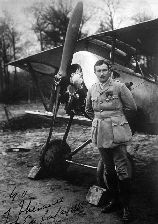 |
 30/4/1916, L'Escadrille au complet - The Escadrille at full strength: Cowdin, Chapmann, Thaw, Bert Hall  ,
De Laage de Meux, Capt. Thenault, Rockwell, Norman Prince,
Mac Connell ,
De Laage de Meux, Capt. Thenault, Rockwell, Norman Prince,
Mac Connell |
 |
||
Norman Prince, Codwin, Thaw prirent
l'initiative du beau mouvement des Américains venant
s'engager pour la Fance.
A sa mort (12 ou 15 octobre 1916),
Norman Prince fut remplacé par son frère ainé Frederick
- Norman Prince was replaced by his older brother
Frederick
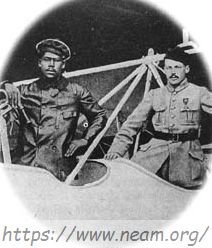 Le Sergent pilote Norman Prince dans
le cockpit arrière d'un bombardier léger Voisin avec
son observateur-tireur alors qu'il était affecté à
VB II3, automne 1915 - Sergent pilot Normon Prince
in the rear cockpit of a Voisin light bomber with
his observer/gunner while assigned to V.B II3, Fall
of 1915.
|
 05 Kiffin Rockwell  Pilote au LaFayette du 18 avril au 23
septembre 1916 - Tué au combat dans les environs de
Roderen (Alsace), le 23 septembre 1916
 Kiffin
Yates Rockwell and his brother Paul in French
military uniforms,1914
|
 Funérailles de l'adjudant Norman Prince - Funeral of Adjudant Norman Prince  Frederick Prince Sgt Frederick Prince Jnr prepares to go up
for a training flight in a Nieuport 11. Norman's elder
brother Fred arrived to take his place in N124 a week
after Norman's (US Air Force Museum)
Le Sgt Frederick Prince Junior se prépare à monter pour un vol d'entraînement dans un Nieuport 11. Le frère aîné de Norman, Fred est arrivé à la N124 pour prendre sa place une semaine après (US Air Force Museum)  L'épave du Nieuport de Norman Prince.
Il s'est écrasé après avoir heurté une ligne
électrique lors de son atterrissage au crépuscule.
Prince a été grièvement blessé dans l'accident et est
décédé quelques jours plus tard.
The wreckage of Norman Prince’s Nieuport after it crashed when it hit a power line while landing at dusk. Prince was seriously injured in the crash and died a few days later. |
||
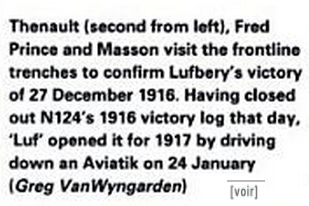 |
 Norman Prince, mort le 15 Octobre 1916,
est enterré dans une tombe à la cathédrale nationale de
Washington.
Norman Prince died on October 15, 1916 buried in an elaborate tomb at the National Cathedral in Washington |
|||
 Guynemer  Didier Masson (23 Février
1886 - 2 Juin 1950) fut un aviateur pionnier
français . Il est né à Asnières, France. Il est mort et
enterré à Mérida, dans le Yucatan, au Mexique. Il
rejoignit l'Escadrille Lafayette avec Edwin C. Parsons et
Charles Nungesser. Plus tard dans la vie, il fut
gestionnaire de Pan American World Airways ainsi que agent
consulaire français.
|
 Lufbery Major Gervais Raoul Victor Lufbery
- Né le 21 mars 1885 à Clermond-Ferrand - Fils de
William Lufbéry et d'Anne Vessière - Avant guerre
mécanicien - Engagé pour la durée de la guerre, au 1er
groupe d'aviation, le 25 août 1914 - Mécanicien de
l'escadrille VB 102 - Brevet de pilote militaire n°
1286 en date du 29 juillet 1915 - Pilote de
l'escadrille N 124 "La Fayette" - Pilote du 94th Aero
Squadron - Tué au combat, à Maron (54), le 19 mai 1918
- 17 victoires homologuées et 15 non homologuées -
Légion d'Honneur - Médaille militaire, le 12 juin 1917
- Croix de guerre 14-18 à 10 palmes - Repose au
Mémorial à la gloire de l'escadrille "La Fayette" au
parc de Villeuneuve à Marne-la-Coquette
|
 Lt De Laage de Meux
Lt Alfred Marie de Lâage de Meux   Pilote de l'escadrille américaine N 124
/ N 124 "La Fayette" du 18 avril 1916 au 23 mai 1917 -
Tué au cours d'un accident d'avion, aux commandes d'un
SPAD VII, survenu au décollage, sur le terrain
d'Eppeville (Ham), le 23 mai 1917
|
||
 Présentation du drapeau de l'Escadrille Lafayette - Presentation of flag to Lafayette Escadrille |
 Présentation du drapeau de l'Escadrille Lafayette - Presentation of flag to Lafayette Escadrille |
 Présentation du drapeau de l'Escadrille Lafayette - Presentation of flag to Lafayette Escadrille |
||
 Un Nieuport en combat amical avec un Farman - A Nieuport in friendly combat with a Farman |
 L'Escadrille après la mort de Prince, Lufbery absent - The Escadrille after Prince's death, Lufbery absent |
 L'Escadrille 42 quitte Lunéville pour bombarder la gare de Metz - Escadrille 42 leaves Luneville to bomb the station of Metz |
||
 |

Tragique photo-les quatre premières
arrivés à l'Escadrille: Mac Connell, Rockwell, Prince,
Chapman (Tous ont été tués) - Tragic photograph-the four
first arrivals at the Escadrille: Mac Connell, Rockwell,
Prince, Chapman (All were killed)
 |
 Tranchées en Alsace - Trenches in Alsace; Oberer, Ochsene, Eldhop |
||
 Tranchées à Eparges. Remarquez les grands cratères provoqués par les obus. - Trenches at Les Eparges. Notice the great mine craters |
 Présentation du groupe (voir leur photo pour les noms) - Presentation of Group (See Photo for names) 1917/07/07 Les pilotes de l'escadrille N 124 "La
Fayette" posent sur le terrain de Chaudun en juillet
1917 - Debouts de Gauche à droite : Adj Robert Soubiran
- Sgt Andrew Courtney Campbell - Ltt Edwin Parsons - Sgt
Ray Bridgeman - Sgt William Dugan - Sgt Douglas
MacDonagle - Adj Walter - Sgt Harold Willis - Sgt
Henry S. Jones - Sgt David M. Peterson - Ltt Louis
Verdier-Fauvety - Assis : Adj Dudley Hill - Adj Didier
Masson avec Soda - Ltt William Thaw avec Whiskey - Cne
Georges Thénault - Ltt Raoul Lufbery - Adj Charles
Johnson - Sgt Stephen Bigelow - Sgt Kiffin Y. Rockwell -
 The Escadrille Lafayette in July
1917. Standing, left to right are Soubiron,
Doolittle, Campbell, Persons, Bridgman, Dugan,
MacMonagle, Lowell, Willis, Jones, Peterson and de
Maison-Rouge (French Deputy Commander). Seated, left
to right are Hill, Masson with "Soda" Thaw, Thenault
(the French Commander), Lufbery with "Whiskey"
Johnson, Bigelow and Rockwell. (U.S. Air Force
photo)
|
 Verdun en flammes - Verdun in flames |
||
 Le Fort de Thiaumont qui a changé de
lignes dix fois, ce qu'il en reste après les bombardements
français et allemands - The Fort of Thiaumont which
changed bands ten times. What is left of it after French
and German bombardments.
|
 Le Nieuport de Cambell après
l'atterrissage avec une aile en moins -
Cambell's Nieuport after landing with a wing missing
|
 Lt Verdier. Le capitaine Thenault et le lieutenant de
Maison-Rouge quittèrent l'escadrille le 5 octobre 1917
pour maladie et le lieutenant Thaw prit le commandement
avec le lieutenant Verdier comme second.
|
||
 Funérailles de Hoskier. Sa mère, son père,
le "ministre". - Funeral of Hoskier. His Mother, Father,
the Minister.
  Convaincu qu'un bi-place est meilleur
qu'un monoplace pour le combat aérien,Hoskier a choisi
le Morane Saulnier Parasol
|
 Funérailles de Hoskier et Dressy - Funeral of Hoskier and Dressy   |
 Incendie causé par Boches sur notre
terrain de Senart - Fire caused by Boches on our
Senart field
 Incendie causé par Boches sur notre terrain de Senart - Fire caused by Boches on our Senart field |
||
 Le Kaiser tient un conseil de guerre après
la bataille de Malmaison. Remarquer son bras chétif
malade. Derrière lui, la Couronne Prix-Hindenburg au
milieu. Tous semblent anxieux (Photo trouvée sur le
corps d'un officier allemand) - The Kaiser holds a council
of war after the battle of Malmaison. Note his withered
arm. Behind him the Crown Price-Hindenburg in the middle.
All look anxious (Photogrph found on the body of a German
officer)
|
  Lowell  - Genet
- Lufbery - Mac Connell
- Genet
- Lufbery - Mac Connell |

L'aérodrome de Ham - Ham Aerodrome |
||
 Chapman, bien que blessé, veut retrouver le combat - Chapman, though wounded, want to renew the fight. Le
Général d'HARCOURT *****: -J'ai vu un pilote
américain, nommé Chapman, blessé à la tête venir
atterrir sur notre terrain, se faire bander et repartir
sur le front - I saw an American pilot named Chapman,
head injuries, who landed on our field, do his band
Aid and start back on the forehead
|
 Paul Rockwell se recueillant au-dessus de
l'endroit où le corps de son frère fut placé.
Hartmannsweilerkopf, en Alsace, en arrière-plan -
Paul Rockwell regarding the spot where his brother was
brought down. Hartmannsweilerkopf, in Elsass, in
background.
Paul Rockwell était l'historien de l'Escadrille. Son frère a été l'un des premiers aviateurs américains tués au combat dans l'unité _ Paul Rockwell was the historian of the Escadrille. His brother was one of the first American aviators killed in combat in the unit. source |
 Un Nieuport Vickers - A Nieuport Vickers |
||
 A Cachy un spad de l'Escadrille Cigogne - At Cachy a spad of the Stork Escadrille |
 Un Fort à l'ouest de Verdun - A Fort at the West of Verdun |
 Un avion ennemi a brûlé le hangar de la Cigogne - An ennemy plane burned the Stork's hangar |
||
 Le bois de Cachy sos la neige - Cachy Wood in the snow  Une attaque en Somme en septembre 1916 On
voit les hommes dans les tranchées - An attack in the
Somme September 1916. One sees the men in the trenches
|
 Dudley Hill changed its nickname 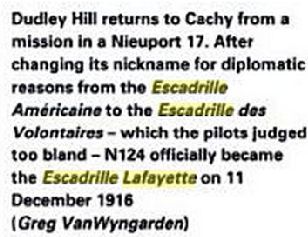 |
 -Le Sgt Dudley Hill met ses gants de vol
avant de monter à bord du Nieuport 17 derrière lui, sur
lequel est porté la tête de sioux adoptée par N124 comme
insigne d'unité à la fin Octobre 1916.
-Sgt Dudley Hill his flying gloves prior to climbing aboard the Nieuport 17 behind him, which bears the Seminole Indian head adopted by N124 as a unit insignia in late October 1916 |
||
 La Somme - l'attaque de septembre 1916 -
The Somme - the attack September 1916
|
 Chaulnes, vue oblique - Chaulnes-oblique view |
 L'Escadrille américaine à Verdun - The American Escadrille at Verdun |
||
 Après le bombardement - After the bombardment |

Thaw, bien que blessé, rejoint
l'Escadrille- Thaw, though wounded, comes back to the
Escadrille
|
 Le champ d'aviation de Senart- Senart aviation camp |
||
 WHISKEY se fait les dents !
  |
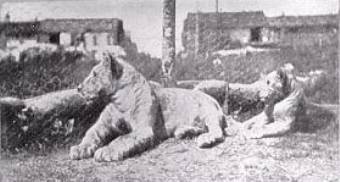 Les mascottes de l'Escadrille Américaine, deux lionceaux nommés Whisky Soda. (Photo US Air Force)  Lufbery et ses lions, Whiskey et Soda - Lufbery and his lions Whiskey and Soda
|

L'AS Luftbery avec les mascottes de l'escadrille La Fayette, WHISKEY and SODA. - The ACE Luftbery with mascots escadrille Lafayette, WHISKEY and SODA  |
||
 Notre mascotte. Le chien Fram - Our
mascots. The dog Fram
|
 Formation - Training |
 Formation - Training |
||
 Le Spad de Luftbery a une déchirure de l'aile haute causé par un obus - Lufbery's Spad struck by shell |
 Notre mascotte, le lion Whiskey - Our mascots. the lion Whiskey |

Remarquer les toitures endommagées par
l'explosion d'obus au croisement ds routes. - Note roofs
damaged by explosion mine at cross roads.
|
||
 La route Roye-Nesles coupée par les trous
d'obus - Roye-Nesles, road cut by mines
|
 Funérailles de Genet. Un officiel. - Funeral of Genet. The Minister. |
|||
 Zeppelin tombant en flammes, touché par
l'artillerie française à Compiègne 17 Mars, 1917. -
Zeppelin falling in flames struck by French artillerie at
Compiègne March 17, 1917.
|
 Les débris d'un Zeppelin
à Compiègne. - Zeppelin brought down at Compiègne |
 Au cours de la progression sur Nesles,
mars 1917 - During the advance Nesles March 1917
|
||
 Le viaduc de Dannemarie détruit par un
bombardement de gros calibre. - The Viaduct of Dannemarie
destroyed by a bombardment of heavy calibre.
|
 Les dégâts d'un obus de gros calibre -
The effects of a heavy calibre shell.
|
 Les bombes ainsi placées se larguent facilement - How the bombs were placed and let fall. |
||
 Le briefing avant le décollage de la
première patrouille. Aucune émotion visible - Assembly for
ordres before leaving on first patrol. No emotion visible.
|
 Bombardier Farman - Farman Bomb Plane |
 Bombardier Farman - Farman Bomb Plane |
||

Un Nieuport en vol - A Nieuport in full flight |
 Un avion allemand abattu près de la deuxième ligne - German machine brought down near the second line. |
 Un avion allemand abattu par Lufbery - German machine brought down by Lufbery |
||
 Un bébé Nieuport armé du canon Lewis
tirant au-dessus de l'hélice - Baby Nieuport armed with
Lewis gun firing over the propeller.
|
 Le terrain d'aviation en Alsace, Romagny - An aviation field in Alsace - Romagny |
 Avion détruit par la tempête (Mai 1916) - Machine destroyed y storm (May 1916) |
||

|
 |
 Liste des pilotes qui ont servi dans
l'Escadrille Lafayette de sa création, 16 avril 1916,
jusqu'au jour où elle a été transférée à l'armée
américaine (1er janvier, 1918) - List of pilots who
served in the Lafayette Escadrille from is formation April
16, 1916, until the day when it was transferred to the
American Army (January 1, 1918)
|
||

LE SERGENT PAVELKA A SALONIQUE -
Le sergent Paul Pavelka est le seul aviateur américain qui défende notre cause à Salonique. Avant de s'y rendre, il avait déjà abattu un avion sur le front français. C'est un remarquable pilote, courageux et adroit. |
 ASSEOIR UN ZINC ! |
 Le caporal Andrew-Walbron Peterson, 4 fois
blessé dans l'infanterie et toujours au front, et le
sergent Paul Pavelka, aviateur, ancien légionnaire, tous
deux Américains.
|
||

|
 SPAD 124 (ESCADRILLE LAFAYETTE) Ajouter:
Cyrus Foss Chamberlain (1889-1918), . Dernier pilote américain à l'Escadrille Lafayette..., Ernest Groves Wold (1897-1918), premier escadron d'observation, en 1917... |
 |
||
 Bert Hall HIGH ADVENTURE BY JAMES HALL Chapter 1a · Chapter 1b |
  "Jimmie Hall," as he was
called, served both in the famous Lafayette
Escadrille, and in the 94th pursuit squadron with
Raoul Lufbery and Eddie Rickenbacker
FIGHTING
THE FLYING CIRCUS
BY EDDIE RICKENBACKER -Eddie Rickenbacker was best known as
one of the Commanders of the 94th
nicknamed "Hat-in-the-Ring" Squadron, a crack unit of
pilots which included many former members of the famed
Lafayette Escadrille.
-Eddie Rickenbacker est surtout connu comme l'un des commandants du 94e surnommé l'escadron "Hat-dans-le-Ring", une unité d'élite de pilotes qui comprenait de nombreux anciens membres de la célèbre Escadrille Lafayette. (94th Fighter Squadron (94 FS), 94th Aero Squadron) |
 James Norman Hall Rickenbacker: Fighting the Flying
Circus
1 - Introducing
"Archy"
2 - The Aerodrome 3 - Our First Sorties 4 - Downing My First Hun 5 - Jimmy Meissner 6 - Jimmy Hall's Last Flight 7 - New Responsibilities 8 - A Victory and a Narrow Escape 9 - Down in Flames 10 - Lufbery is Killed 11 - Squadron Festivities 12 - Jimmy Meissner Again 13 - America's First Ace 14 - Rumpler Number 16 15 - Campbell's Last Flight 16 - Becoming an Ace 17 - A Perplexing Bank of Fog 18 - Strafing the Drachen 19 - The Château Thierry Salient 20 - The Death of Quentin Roosevelt 21 - The Flying Circus Scores Heavily 22 - Ours Spads Arrive 23 - Back Close to Verdun 24 - The St. Mihiel Drive 25 - American Ace of Aces 26 - Captain of the Hat-in-the-Ring Squadron 27 - An Eventful "D" Day 28 - Frank Luke Strafes His Last Balloon 29 - A Night Mission 30 - A Day's Work—SixVictories 31 - Seeing the War 32 - A Regular Dog-fight 33 - An Aeroplane Movie Show 34 - An Over-Zealous Ally 35 - The End Draws Near 36 - Last Victory of the Great War |
||
 Edward Hinkle |
 L'hiver - Winter 1916/1917 |
 Willis B. Haviland (1890-1944) |
||
| LES
STARS DE L’AVIATION : L’ESCADRILLE LAFAYETTE Où l’Escadrille Lafayette devient un
sujet de propagande portant les espoirs des pays de
l’Entente.
|
 |
|||
Trois photographies consacrées à l’escadrille La Fayette: Aérodrome à Ham, 1917, Aérodrome et Défilé des troupes à la cérémonie de la présentation du drapeau américain à l’Escadrille La Fayette. De nombreuses photographies, largement reprises par la presse, montrent aux civils lassés par l’horreur et la monotonie des tranchées les images nouvelles d’une guerre moderne, chevaleresque, plus noble, plus propre et plus supportable. Les pilotes sont des héros qui font rêver, et les avions sont présentés comme les armes invincibles de la victoire à venir. Le fait qu’il s’agisse ici d’une escadrille de volontaires américains est aussi très significatif. |
 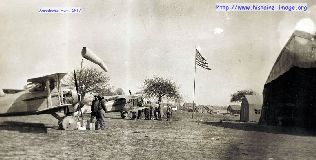  |
|||
| Ajouter: Cyrus Foss Chamberlain (1889-1918), diplômé de l'Université de Princeton en 1910, s'engage dans le Service aéronautique de France à Paris. Dernier pilote américain à l'Escadrille Lafayette, formé à Avord, Pau, et la GDE, affecté sur le front à la SPAD 85 puis à la SPAD 98, est abattu dans un combat aérien de patrouilles avec 13 combattants ennemis près de La Ferté-Milon. (à titre posthume la Croix de guerre de la France, avec Palm). En 1928, les restes de Chamberlain ont été exhumés du cimetière militaire à Coulommiers, en France, au mémorial Lafayette Flying Corps, près de Paris. L'autre pilote est Ernest Groves Wold (1897-1918), diplômé de Minneapolis West High School en 1914, formé au Camp d'entraînement des officiers à Fort Niagara au début de la Première Guerre mondiale, muté dans l'aviation, lieutenant, est allé en France, est devenu membre de l'Escadrille Lafayette, premier escadron d'observation, en 1917, établit un record d'altitude en 1918, est tué en combat près de Château-Thierry. -Cyrus Foss Chamberlain (1889-1918,) the son of Francis A. Chamberlain, a Minneapolis banker, and Frances Foss Chamberlain, was born in Minneapolis, attended Minneapolis public schools, graduated from Princeton University in 1910, was a partner in the Marsh & McLennan insurance firm until 1917, sailed for France aboard the S.S. Chicago to enter World War I, enlisted in France's Service Aeronautique in Paris, the last American in the Lafayette Escadrille, attended the aviation schools at Avord, Pau, and the G.D.E., was assigned at the Front to Escadrille SPAD 85, was reassigned to SPAD 98, and flew combat patrols with that squadron until his death in a mixup with 13 enemy fighters near La Ferte-Milon. Sergeant Chamberlain was posthumously awarded France's Croix de Guerre, with Palm. In 1928, Chamberlain's remains were removed from the military cemetery at Coulommiers, France, to the Lafayette Flying Corps memorial near Paris, France. In 1921 or 1923, Wold-Chamberlain field in Minneapolis, the current Minneapolis-St. Paul International Airport, was named in his honor. The other pilot honored in the air field name was Ernest Groves Wold (1897-1918,) who was the son of Theodore T. Wold (1868- ,) who grew up in the Lowry Hill neighborhood of Minneapolis, graduated from Minneapolis West High School in 1914, attended Officers' Training Camp at Fort Niagara at the start of World War I, transferred to aviation and was commissioned a First Lieutenant, went to France, became a member of the Lafayette Escadrille, First Observation Squadron, in 1917, flew observation planes to photograph enemy locations, established an altitude record in 1918, and was killed in action near Chateau Thierry, France. source http://www.angelfire.com/mn/thursdaynighthikes/fairoakhike.html |
|||||
|
|||||
voir
aussi |